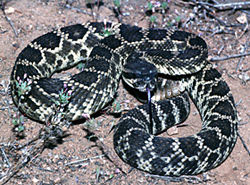
THE BABY RATTLESNAKES ARE OUT
and THEY ARE SILENT and DEADLY
When the sun starts heating up the earth and making the rocks hot along Dry Creek in Middletown, California, the baby rattlesnakes start coming out and could strike you, your kid or dog.
Baby rattlesnakes are born alive not hatched from eggs - that means that the mother rattlesnake is nearby when they are born and begin to adjust to life on earth. They are extremely venomous and when they strike they are too young to control their poison release so they keep "pumping it in you" and you or your dog, cat or horse could die. See about getting the rattlesnake venom shot from the Middletown vet.
Snake, Rattle, and Roll - Watch Out Dogs, Cats, and Foals!
From the Middletown Animal Hospital
It's summertime! It's hot and dry--the perfect conditions for the rattlesnakes to be out and about. While pursuing outdoor activities like taking our dogs to the lake, playing out in the backyard, or riding our horses on the trail, it is also important to keep an eye out for rattlesnakes. Be aware that rattlesnakes are out there, they are dangerous, and we need to know what to do in case our animals become victims.
A rattlesnake bite is deadly because of its venom. Venom rapidly disables prey and initiates digestion of the tissue. Its main actions kill cells, cause damage to the vasculature, muscle, and nerves, as well as creates clotting abnormalities. Venom can cause your pet to go into shock and bleed to death. Interestingly death can occur within minutes, hours, days, or even weeks. Venom's actions may have long-lasting effects if not neutralized. Each bite is unique because the amount of venom injected and the sensitivity to that venom varies greatly.
Although an animal can be bitten anywhere on its body, the most common sites are the face or the feet. The most common sign is rapid swelling of the site and surrounding tissue with two small black dots visible (the fang marks). While one pet may have severe swelling within 30-60 minutes, others may be less noticeable and only show progression after 6-8 hours. However, either case is an emergency and should be seen by a veterinarian immediately! Other signs are: bruised gums, severe pain, lethargy, shock, and black or sloughing skin.
Horses are the most sensitive of all the domestic animals to rattlesnake venom. Horses bitten on the muzzle are in danger of suffocating if their nostrils swell shut„this is because horses cannot breath through their mouths. In this case, your veterinarian may instruct you tie the horseÍs head in an elevated position and to place 10î pieces of garden hose up the nostrils. It is critical to be able to do this because it could mean the difference between life and death for your horse. In all instances, get a veterinarian as soon as you can!
The ONLY treatment that neutralizes snake venom and gives an animal the best chance of survival is anti-venom. There are other medical treatments that veterinarians will perform for supportive care, but the number one treatment is antivenom! Even if a pet was bitten two days prior, the antivenom is still beneficial- it can be used up to 60 hours post-envenomation. Be prepared, however, because antivenom is the most expensive drug in a veterinary hospital- about $700 per vial!
If you have any question as to whether your pet has been the victim of a rattlesnake bite, please do not wait or hesitate to call your veterinarian. Animals can still succumb to snakebites even if seen immediately and given antivenom, but their best chance is rapid treatment. Other helpful tips are: keep your pet inside during the hottest and driest parts of the day, walk the other way if you hear a rattlesnake (this often sounds like water hissing from a pipe!), and ask your veterinarian about the benefits of the rattlesnake vaccine.